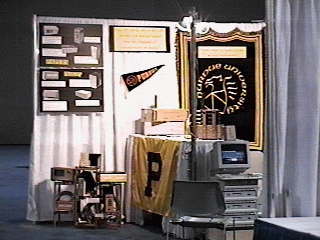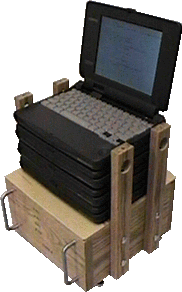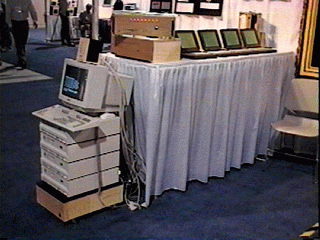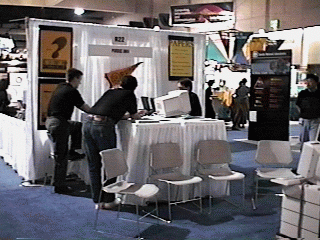 December 1995
December 1995
IEEE/ACM Supercomputing
 December 1995
December 1995
IEEE/ACM Supercomputing
Supercomputing 1994 had been a very positive experience for us and a lot of good exposure for Purdue and our work, so we wanted to do much the same for 1995. However, San Diego isn't a road trip like Washington D.C. was, so we had to cut back on the quantity of stuff being brought to the show. Thus, instead of a 20' by 20' booth with four clusters, we simply had a 10' by 20' booth (R22) with two clusters on one end and software displays on the other end.
 The hardware side.
The hardware side.
The hardware side of the booth displayed two clusters. One cluster
was the rather familiar group of four IBM ValuePoint 486DX33 machines
running Linux. The other four-machine cluster was built specifically
to be easy to carry around for demonstrations. Named the "TTL_PAPERS
Microcluster," it consists of a group of four Compaq Aero subnotebook
computers and a miniature oak rack mount.
 TTL_PAPERS Microcluster.
TTL_PAPERS Microcluster.
Since they only have 486SX25 processors (without floating point
hardware), the microcluster machines are not fast. However, the
entire cluster only weighs about 30 pounds and fits within a 1' cube.
The miniature oak rack mount houses a four-machine TTL_PAPERS unit,
power supplies, and space to pack both an extension cord and the
cables for the TTL_PAPERS unit. This TTL_PAPERS unit is the design
from November 1994, as described in the HTML
handout. For travel, there is an oak top plate that secures the
laptops and provides a shoulder strap, while a plate with three wheels
attaches to the bottom with velcro... in summary, it can go anywhere
and can even be run using battery power.
 Heterogeneous cluster.
Heterogeneous cluster.
Because Supercomputing '95 also marked the release of our scalable
eight-machine TTL_PAPERS 951201 design, all day December 6, 1995, we
demonstrated an eight-machine cluster using the obviously
heterogeneous combination of the four ValuePoints and the four Aeros.
An HTML handout describes the 951201 design.
A variation of the multi-voice music demo clearly demonstrated the
tight coupling of machines within this cluster.
 PAPERS history.
PAPERS history.
In addition to the TTL_PAPERS units that were operating in our booth,
there was a TTL_PAPERS 950801 unit and a wooden plant rack holding
various earlier PAPERS prototypes. While we are on the topic, the
quality of the woodwork for the PAPERS cabinets was yet again heading
the list of comments from visitors to our booth... maybe there is a
message there for commercial computer vendors...?
 The software side.
The software side.
On the other side of our booth, just past the circle of chairs gathered
around the ValuePoint cluster, were two tables for the software
demonstrations for our booth. The KIWI project took
one table, the TTL_PAPERS (and TTL_VAPERS simulator) library took the
other. An HTML handout describes the
library. We also had an HTML handout on the
new giveioperm() system call for secure direct port
access under Linux.
 PAPERS booth people.
PAPERS booth people.
Well, after the description of what we did in our booth, it's kinda
nice to have a photo of the folks who made the booth happen. From
left to right, the PAPERS booth people are R. Hoare, R. Fisher, T.
Mattox, S. Kim, and H. Dietz.
Incidentally, a lot of things are available on-line from the Supercomputing 1995 conference. The complete proceedings, abstracts for the exhibits, etc., are available from http://sc95.sdsc.edu/SC95.
The next public demonstration of PAPERS at a conference was August 1996 at the International Conference on Parallel Processing.